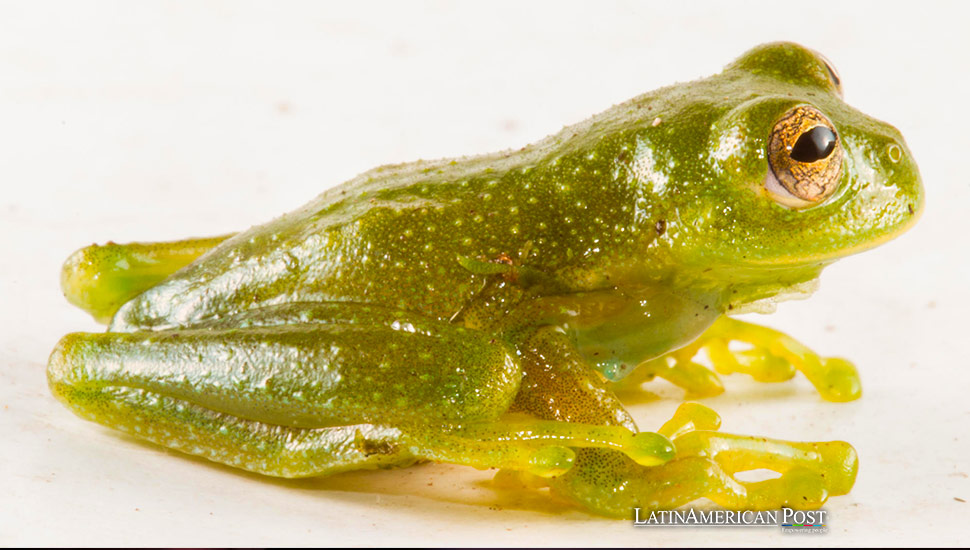New Species of Glass Frog Discovered in Ecuador

Researchers in Ecuador have discovered a new species of glass frog, named ‘centrolene kutuku’, in the Amazon region, featuring a transparent belly that intriguingly reveals its internal organs.
In a remarkable revelation from the depths of the Ecuadorian Amazon, scientists have announced the discovery of a new species of glass frog, intriguingly marked by a transparent abdomen that showcases some of its internal organs. This significant find was detailed in a recent press release by the Ecuadorian Institute of Biodiversity (Inabio), highlighting the ongoing richness and mystery of the Amazon’s biodiversity.
The newly discovered frog, named ‘centrolene kutuku,’ honors the Kutukú mountain range where it was found. This region, part of a massif that predates even the Andes, has unveiled its first known glass frog species, marking a significant milestone in the study of the area’s diverse wildlife. The centrolene kutuku is a unique species, known for its distinctive transparent skin and its transparent abdomen that showcases some of its internal organs. This characteristic continues to fascinate scientists and nature enthusiasts alike.
The discovery was a result of a collaborative effort between Inabio, the Pontifical Catholic University of Ecuador (PUCE), and the University of San Francisco of Quito (USFQ). This joint effort ensured a comprehensive understanding of the centrolene kutuku’s unique habitat and environmental preferences, providing a solid foundation for future conservation strategies.
Under Threat: The Plight of the Glass Frog
However, this remarkable discovery comes with its challenges. The Inabio has raised alarms regarding the threats posed by mining concessions in the area, which are not currently part of any protected zones. The extraction activities pose significant risks to the newly discovered species and its habitat, potentially leading to detrimental impacts if not carefully managed or regulated. This underscores the urgent need for effective conservation measures to protect this unique species and its habitat.
The ecological significance of the centrolene kutuku extends beyond its novelty. The species’ potential distribution within the Kutukú Range is still being studied, with further research necessary to fully understand its population status and the risks it faces from environmental degradation and human activity. The Inabio emphasizes the need for ongoing investigations to ascertain the full extent of the frog’s habitat, ensure its protection, and implement conservation strategies to safeguard this species for future generations.
A Deeper Look at Evolution and Conservation
The researchers involved in the discovery of the centrolene kutuku conducted extensive anatomical and coloration analyses alongside molecular studies to determine the evolutionary relationships of this glass frog. Their findings not only shed light on the species’ genetic lineage and developmental history but also highlight its evolutionary ties to other glass frog species across the Andes.
One such relative is the Campos glass frog, found on the opposite side of the Andes in the coastal province of El Oro. This unusual pattern of distribution, with sister species located on opposite sides of major geographical barriers, is rare and provides valuable insights into the region’s historical biogeography.
Published in the international scientific journal Zoosystematics and Evolution’, the research also expands the known geographical range of the Zarza glass frog (centrolene zarza). It evaluates the presence of the Mueller’s glass frog (centrolene muelleri) in Ecuador, previously only recorded in Peru. This comprehensive study not only catalogs new species but also enhances our understanding of the biodiversity in the Andean and sub-Andean regions, contributing to broader efforts in conservation biology.
Also read: Black-Coated Squirrels Discovered in Ecuador’s Andean Regions
The discovery of the centrolene kutuku is a reminder of the rich biodiversity hidden within the Ecuadorian Amazon. It underscores the critical need for continued research and conservation efforts in these vulnerable ecosystems. As mining and other human activities encroach on these areas, balancing economic interests with the urgent need to preserve our planet’s biological heritage remains challenging. This new finding is a call to action for both the scientific community and policymakers to ensure that the natural wonders of Ecuador and the Amazon at large are protected for the region’s ecological health and the enjoyment of future generations.





